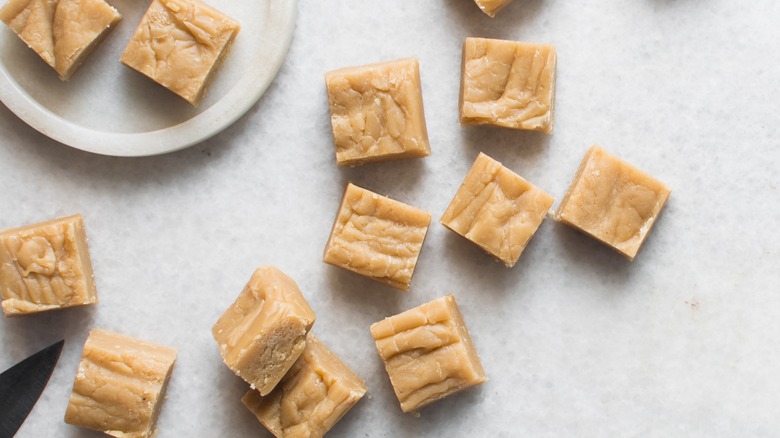Why You Should Always Splurge On High-Quality Chocolate When Making Fudge
You might not have put a ton of thought into the chocolate used in fudge recipes other than the variety: white, dark, or milk. It's mixed with other ingredients anyway (namely a hefty amount of sugar), so how much can the quality of the chocolate matter? Although you might be tempted to reach for the cheapest chips at the grocery store, making the small investment in high-quality chocolate will result in the best fudge. We asked Preston Stewart, director of chocolate at Onyx Coffee Lab, to tell us just why that is. "Mass produced chocolate typically is made from low quality cocoa beans that have lots of defects and therefore they roast them very hot to mask/cover these off flavors," he said. The high heat brings out a bitterness in the chocolate that will undoubtedly affect the final flavor of your fudge.
It's the same case for cocoa powder, as lower-quality ones tend to undergo more processing (cocoa powder is alkalized, or Dutched, during processing), This "typically makes the flavor more dark, coming across as bitter, than the bright or fruity notes found in non-Dutched (or Natural) cocoa powder," according to the chocolatier. So although all those bags or bars of chocolate might appear the same, Stewart said "there are big differences in quality (often associated and discernible by the price)." Using the best one will ensure your finished fudge is perfect in both flavor and texture.
Fudge is nuanced, and chocolate can make or break it
The process of making fudge the traditional way involves melting sugar with cocoa or chocolate and milk, cooking the mixture to the right temperature, then letting it set. The tricky part is cooking the mixture without the sugar crystallizing or burning, which will make for a grainy and crumbly fudge rather than a smooth and creamy one. To do so, it's crucial to avoid stirring the mixture while it cooks — but that doesn't mean you shouldn't stir it at all. The biggest mistake people make with homemade fudge is not stirring the mixture enough at the correct time. After it reaches the ideal temperature, let your fudge cool down without touching it until it reads 110 degrees Fahrenheit, then stir it vigorously. And then keep stirring. Eventually, the mixture should become creamy and cohesive.
As mentioned, using good chocolate will help achieve that texture since there are fewer additives, a higher fat content, and a lower sugar content in quality chocolate that will make the process easier. Which type you scoop up at the grocery store is obviously up to you. We love dark in a dark chocolate raspberry fudge or a festive dark chocolate peppermint fudge, but anything from milk to white can be used with delicious results.

